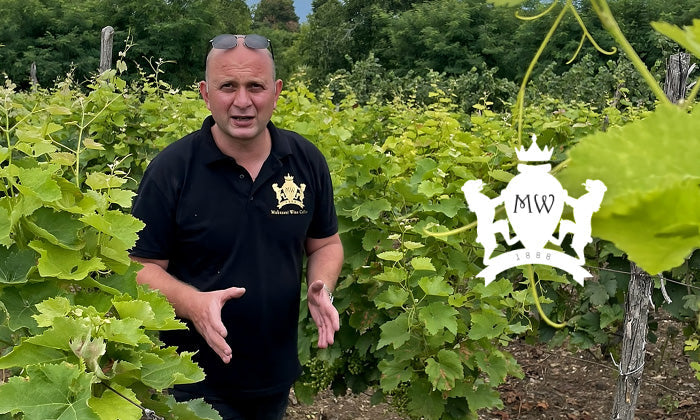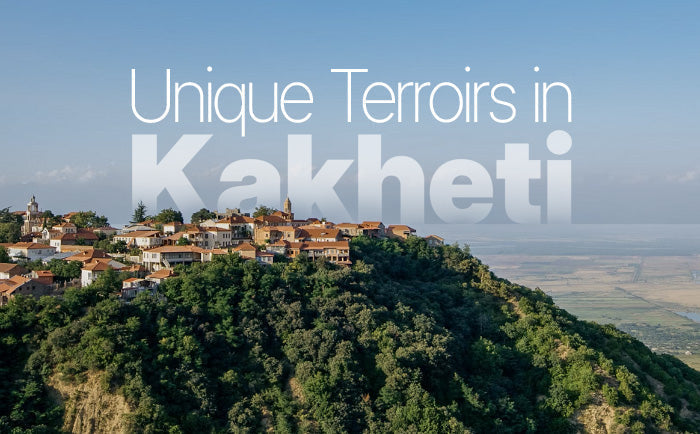
Mukuzani Wine Cellar — Between Two Worlds
In this interview with Mukuzani-born winemaker Vako Katamadze, we trace a journey from childhood nostalgia and a grandfather’s vineyard to formal enology training in Germany and the creation of two wineries—one in Kakheti and one in Rheingau. He shares how early fermentation struggles led him to Mayschoß, how Pinot Noir unexpectedly thrived in Mukuzani, and why elevation and site have reshaped his approach to both Georgian and international varieties.


Sure. I was born and raised here in Mukuzani, until I was about 14. After that, my family emigrated and we lived in different countries. Anyone who’s lived abroad knows how intense the nostalgia can get. I also had a very strong emotional bond with my grandfather — we used to make wine together. And when he passed away, and we eventually ran out of the wines he’d made over the years, we came to a realization: without our own family wines, we didn’t have many options left. Back then, the renaissance of Georgian wine was just starting, so most of the accessible wines were low-quality, mass-produced ones from the supermarket.
This was around 2015–2016. That’s when I realized I had to start making wine myself — especially since my grandfather had left me a vineyard. Not a large one, but planted in a great terroir nonetheless. The problem was, I was still living abroad. My family was based in Germany, so I could only come to Kakheti on short visits — mostly for harvest. I have to mention that I started all of this with my very close childhood friend Michael Beriashvili, who I grew up with here in Mukuzani. Sadly, he passed away last year. Mishiko was responsible for everything vineyard-related. He helped me take care of my grandfather’s vineyard, and once we reached harvest, I just didn’t want to sell the grapes to a factory. The only option left was to try and make the wine myself.
That first experience was, let’s say, very educational. I ran into a lot of issues — especially with fermentation. Sometimes it didn’t go through completely, sugars weren’t fully consumed, and I had lots of questions no one could really answer. That’s when I decided I needed to study enology professionally. I started looking for winemaking schools in Germany and eventually ended up at Winzerverein Mayschoß — one of the oldest winemaking cooperatives in the world.
Yes. That’s when we started laying the first real foundations of what you see here today. We started with building the underground cellar.
Yes. The house is here, and we had just two Qvevris back then. That’s where I made my first vintage. I finished my winemaking studies in 2019, so 2019 was the first vintage I made as a trained winemaker — and it ended up being a very important one. The wines turned out really well — both commercially and based on the feedback we received. I even got multiple awards for them over the next couple of years. That gave me a lot of encouragement to keep going.



The attitude toward me was unique — not only because I was Georgian, but also because I was 39 years old. Much older than most of the students. It was very clear I wasn’t there because someone made me do it — I was there to actually study winemaking. After just a couple of months of hands-on training, I became the cellar master of one of the wineries in the program — with assistants working under me.
My initial target was around 10,000 bottles. That’s what I was building for — both in the cellar and in the vineyards. But that plan quickly changed. After the first vintage, demand was much higher than I expected, and I ran out of wine almost immediately. That pushed me to buy more barrels, more stainless tanks — and thankfully, I already had 16 Qvevris buried in the marani.
All of that was part of the plan from the beginning, but our focus was wine production. So all the resources and energy went there first. The tasting and event areas were finished just a few months ago — and we’re still not entirely done. We’re currently building a small hotel on the property, so wine enthusiasts can come, taste, stay overnight, and continue exploring Kakheti the next day.
We grow all the classic Kakhetian varieties, of course. But what really fascinated me was the Kakhetian Pinot Noir. During my studies in Germany, I almost exclusively worked with Pinot Noir — so it was very interesting to see how it behaves here. I first found a small vineyard, brought in the fruit for a vintage, and I was so pleased with the results that I actually bought the vineyard.

We’re in classic Saperavi country — where wines range from medium-bodied to super extracted — and the Pinot Noir I’ve worked with here has been really extracted. It behaves in a radically different way from what I was used to in Germany.
I can’t speak for the whole region, but in my vineyards it’s actually one of the easiest varieties to grow. Low disease pressure, ripens easily — it’s been a pleasure to work with.
Yes. I also have Chardonnay, which I make into an amber wine in Qvevri — full skin contact for 7 months. That’s also been fascinating. Obviously, Rkatsiteli is the main variety of Kakheti, but I think there’s value in experimenting with international varieties too. It keeps things interesting.
We’re at about 10 hectares total, across different terroirs. Some newly planted, some already producing, some older vineyards we inherited or purchased.


Of course. Mukuzani is a fascinating place for Saperavi. We’re surrounded by several PDOs, so I get to experiment with different styles. I work with fruit from places like the Papari Valley of Akhasheni, and also from my vineyards in Vazisubani — specifically a terroir called Lomiauri. It’s a mountain foothill vineyard, and I’ve actually built an entire wine line around it — the Lomiauri brand. And even within Mukuzani village itself, we’re identifying unique micro-terroirs that we treat separately.
Yes — together with my partner, we have a winery in the village of Oestrich-Winkel, in the Rheingau. We have some very old Riesling vineyards — some over 120 years old. We make Rieslings exclusively there. They’re mostly sold in Germany, but we also bring some to Georgia.
Not yet. But more interestingly, I bought a plot here in Mukuzani at around 1,200 meters elevation. It’s at the foothills, and I’m planning to plant Riesling there. I think that’s the place to start experimenting with skin contact. Considering how successful and unique the Pinot Noir has turned out, I’m really looking forward to trying it with Riesling too.
From the years I’ve worked, 2017 and 2019 were standout vintages. Then we had a few average ones, and one terrible one — 2023. But 2024 looks like it has the potential to be really good again.



It’s been tough. Very irregular. Especially for Saperavi — flowering started late, and we had a cold and rainy period that extended the flowering longer than usual. That complicates everything — even harvest — because it will probably happen later than normal. That brings risks like birds and autumn rains. We’ve also had to spray more than usual this year — and that’s the case across Kakheti. But to be fair, nature kind of did what we would’ve done ourselves — it reduced the crop, which usually means better fruit. So if the rest of the season goes well, we should be looking at very good results.
We work with three brands. That includes classic white wines, Qvevri amber wines, reds, reds aged in oak, and a premium line that includes reserve and late-harvest wines. These premium ones are made from grapes left to dry on the vine — kind of like an appassimento approach, but instead of drying in the cellar, they dry naturally on the vine.
Yes. Most of my wines see oak — Caucasian, American, and French. I like to experiment and blend different barrel types. But I also have red wines that skip oak entirely — like my 2024 Pinot Noir, which was fermented and aged in Qvevri. Sometimes Qvevri alone is enough stylistically, and this Pinot is a good example. It’s very fruit-forward but complex, with layers, and doesn’t need oak to shine.
Like I mentioned, we’ve just opened the marani for tastings, and we have the event space ready. We’re now working on finishing the small hotel on site. Beyond that, I’m really excited for our young vineyards to reach full production — that’s when we’ll really get to explore more varieties and more styles. There’s a lot ahead. Definitely exciting times.


